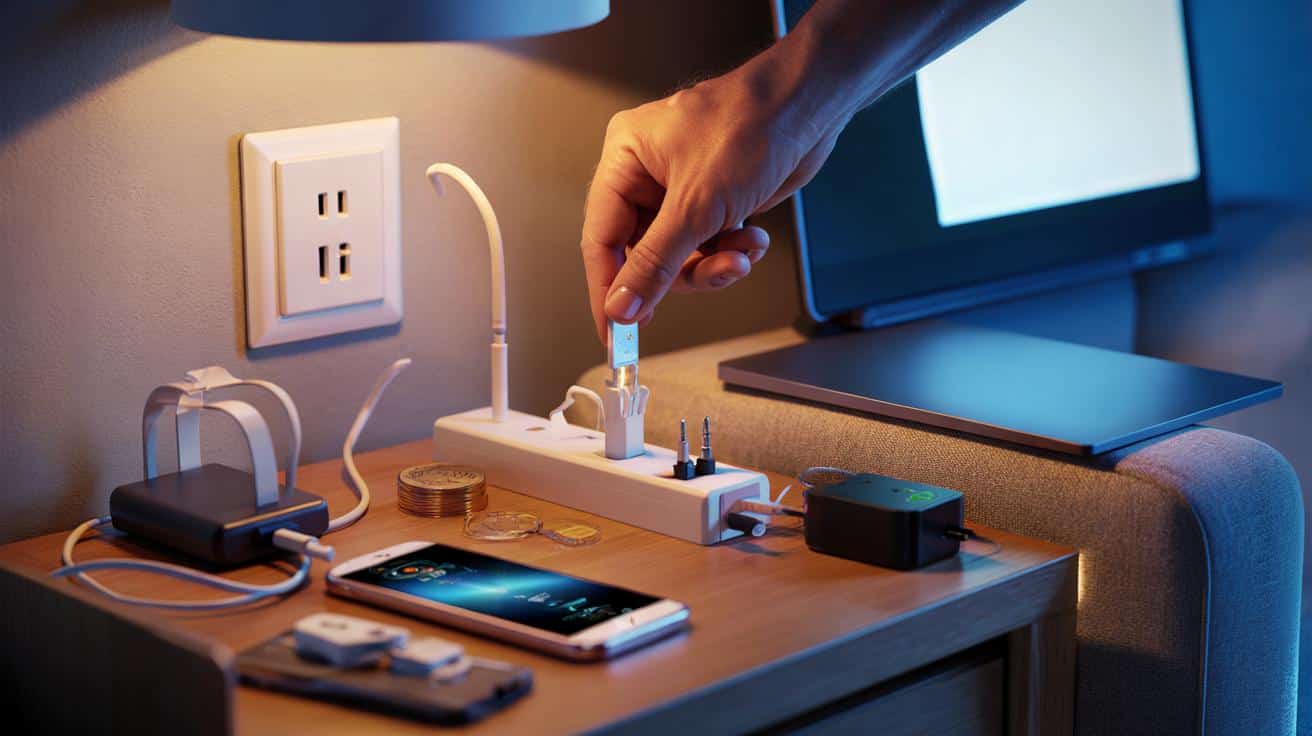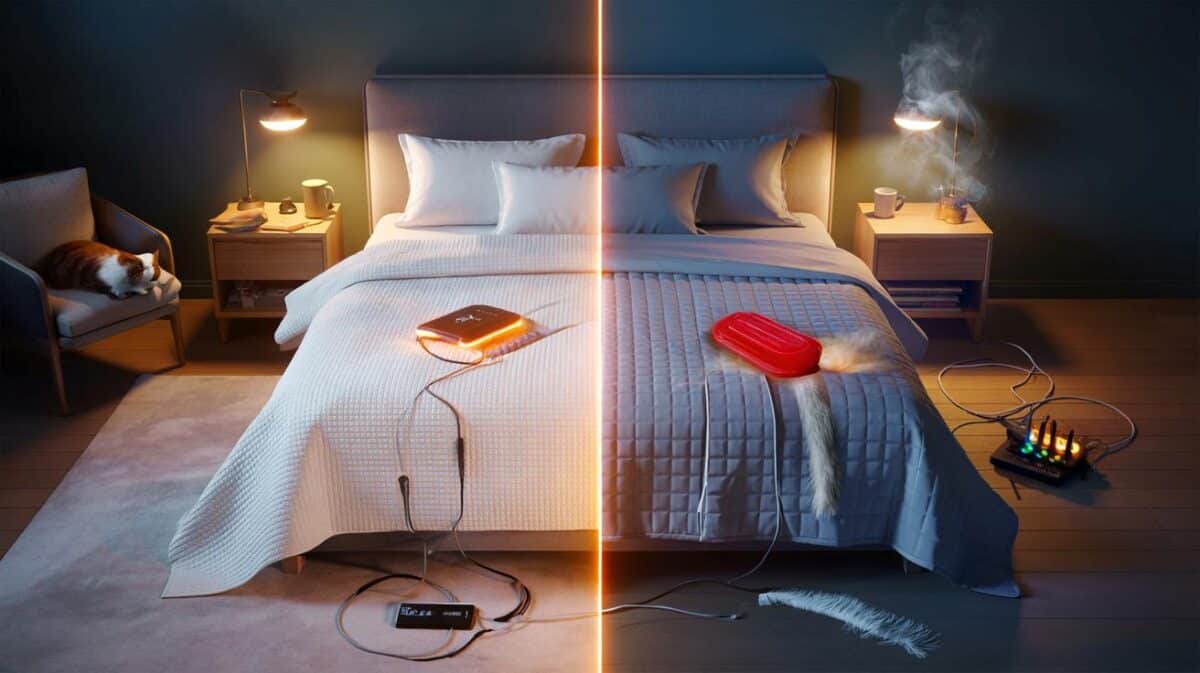There’s a tiny red LED by your socket that never blinks. A phone cable coiled like a sleeping cat. A laptop brick that feels warm on a Tuesday lunchtime. The real cost of leaving chargers plugged in isn’t dramatic in a single day — but it’s there, quietly compounding, all year long.
The kettle was idle, but the phone charger sat in the wall like a tap left dripping, giving off the faintest warmth. We’ve all had that moment when you skim a bill, sigh, and wonder which little thing is nibbling your money.
Later that night, I ran my hand over a laptop brick under the sofa. Warm again. A whisper of watts, always on, always sipping. *It’s not nothing.*
What does that whisper cost?
The real cost hiding in plain sight
Here’s the honest picture. A modern phone charger left in the wall with nothing attached typically draws 0.05–0.3 watts. That’s barely a glow — roughly 0.4–2.6 kWh a year, or 10–70 pence at around 25–30p per kWh. Not scary. Multiply it by ten stray chargers, though, and you’re suddenly looking at a couple of quid that bought you, well, nothing at all. The bigger creep arrives when a device is connected and full. Battery management keeps things alive, and that can average 0.5–1 watt through the night.
Take a house with four phones charging from 11pm to 7am. That eight-hour window at roughly 1 watt of trickle is about 2.9 kWh per device per year. Four devices? About 11.7 kWh — roughly £3–£4 that you never felt. Add two laptops kept on sleep with the chargers in, averaging 2–3 watts each across the week, and you can tack on another 35–50 kWh in a year. That’s where the money hides. Small on paper, real on a bill.
Why it happens is simple physics and policy colliding with habit. Most newer chargers are efficient by design, with “no load” consumption squeezed low by eco-standards. The catch is our routines. Leaving a brick in the wall isn’t pricey; leaving a device sipping on it is. Even a gentle 1–3 watt drip over 8,760 hours turns into 9–26 kWh annually. At 28p per kWh, that’s £2.50–£7.30 — for a single brick. A few like that in every room and **pennies become pounds**.
Cut the waste without making life harder
Start with the easiest win: create one “charging bar” per room. Use a switched extension with six sockets, mount it where you actually drop your tech, and flick it off when you leave or go to bed. If you can, put the bar on a smart plug and schedule it to kill power from 11:30pm to 6:30am. That single routine cleans up the trickle from phones, tablets, watches, earbuds, and controller docks in one thumb press. It’s the difference between good intentions and a habit that sticks.
Work with your day, not against it. Bundle actions: kettle on, charging bar off; coat on, charging bar off. If you’re curious, a £10–£15 plug-in power meter will show the truth in numbers, and that’s motivating. Let’s be honest: nobody does that every day. So make it automatic where you can and forgiving where you can’t. Your laptop? Shut it down once or twice a week instead of eternal sleep. Your toothbrush base? Charge weekly, not forever.
This isn’t about guilt; it’s about control you can feel in your hand. Here’s the rule I keep hearing from people who audit homes for a living:
“Unplug the little things, but tackle the big sleepers first.”
- Phone charger, idle: ~0.05–0.3W (10–70p/year)
- Laptop brick, idle: ~0.2–0.8W (£0.50–£2/year); connected to sleeping laptop: 2–4W (£5–£11/year)
- Controller/earbud dock: 0.5–1W (£1.40–£2.80/year)
- Electric toothbrush base: 0.5–1W (£1.40–£2.80/year)
- Old “fat” bricks (routers, speakers): 1–3W (£2.80–£8.40/year)
So how much could you save per year?
If your home is mostly modern kit, leaving a few phone chargers in the wall probably costs you only a couple of pounds across the year. The bigger swing — £10, £20, **even £30–£40** — shows up in homes with multiple laptops on sleep, toothbrush bases on forever, controller docks lit up nightly, and older, heavier bricks that run warm. A simple bedtime schedule plus a tidy “charging bar” habit can chop that down without any drama.
There’s more than money here. Quiet sockets run cooler, and cheap, unbranded bricks spend less time powered. Your headspace gets lighter when a single switch declares “off” for the whole tangle. The carbon side matters too. Trim 20–50 kWh a year and you’re shedding roughly 4–10 kg of CO₂ on a UK grid averaging about 0.2 kg per kWh. Small? Yes. Meaningful when a street does it? Definitely. Flick once, walk away, share the trick with a neighbour.
| Key points | Detail | Reader Interest |
|---|---|---|
| Idle isn’t zero | Modern chargers sip 0.05–0.3W even with no phone attached | Why your sockets feel warm for “no reason” |
| Connected trickle adds up | 1–3W overnight becomes £3–£11 per device per year | Real numbers you can compare to your bill |
| One-switch solution | Use a switched strip or smart schedule to kill a whole cluster | Immediate, low-effort savings |
FAQ :
- Does a plugged-in charger use electricity with no device attached?Yes, a tiny amount. Most newer ones draw around 0.05–0.3W, which is pennies per year — multiply it by many chargers and it adds up.
- How much can I save by unplugging my phone charger?On its own, often under £1 per year. If it’s frequently topping up a full phone overnight, expect closer to £2–£4 annually.
- Are smart plugs worth it for chargers?Only if they control several devices at once. A smart plug can draw 0.5–1W itself, so use it to switch off a cluster, not a single tiny charger.
- Is it safe to leave third‑party chargers plugged in?Branded, certified models are better. Cheap, unverified bricks can run hotter and age poorly. If a charger is warm when idle, consider replacing it.
- What’s the biggest “vampire” in most homes?Not the phone charger, but sleeping laptops, docked gadgets, and older power bricks. Tackle those and **switch the strip off at the thumb**.








